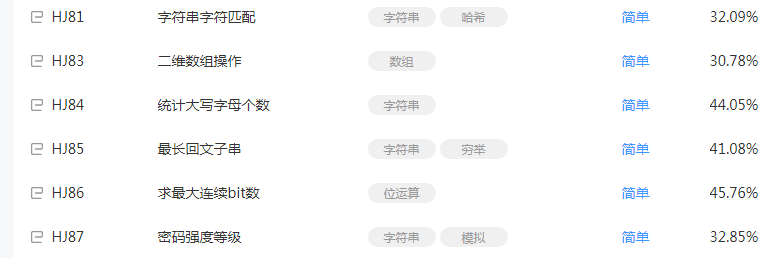
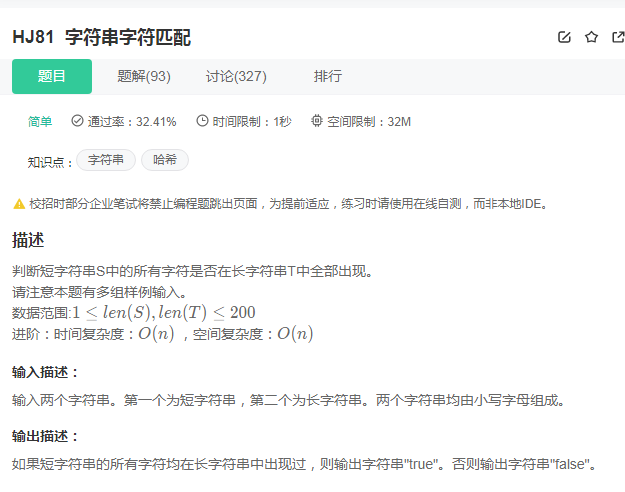
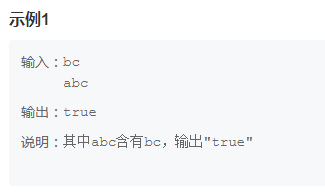
参考答案

1 ############################ 2 while True: 3 try: 4 s = input().lower() 5 str1 = input().lower() 6 s2 = [] 7 8 for a in range(len(s)): 9 if s[a] not in str1: 10 s2.append(s[a]) 11 12 if len(s2) != 0: 13 print('false') 14 else: 15 print('true') 16 17 except: 18 break 19 ######################################################## 20 21 while True: 22 try: 23 S, T = input(), input() 24 if set(S) & set(T) == set(S): 25 print('true') 26 else: 27 print('false') 28 except: 29 break 30 ######################################################## 31 while True: 32 try: 33 S, T = input(), input() 34 if set(S) & set(T) == set(S): 35 print('true') 36 else: 37 print('false') 38 except: 39 break 40 ######################################################## 41 42 while True: 43 try: 44 short_str = input() 45 long_str = input() 46 for t in short_str: 47 if long_str.count(t)==0: 48 print("false") 49 break 50 else: 51 print("true") 52 except: 53 break 54 55 56 ######################################################## 57 def judge(s1,s2): 58 for i in s1: 59 if not i in s2: 60 return 'false' 61 return 'true' 62 while 1: 63 try: 64 print(judge(input(),input())) 65 except: 66 break 67 68 ######################################################## 69 70 while True: 71 try: 72 a = list(input()) 73 b = list(input()) 74 len_a = len(a) 75 len_b = len(b) 76 if(len_a > len_b): #保证a始终是短的字符串 77 c = a 78 a = b 79 b = c 80 c = len_a 81 len_a = len_b 82 len_b = c 83 k = 0 84 flag = 0 85 for i in range(len_a): 86 for j in range(len_b): 87 if(a[i] == b[j]): #若a的字符在b中出现 88 flag += 1 #flag + 1 89 break 90 if(flag == len_a): #若都出现 91 print('true') 92 else: 93 print('false') 94 except: 95 break
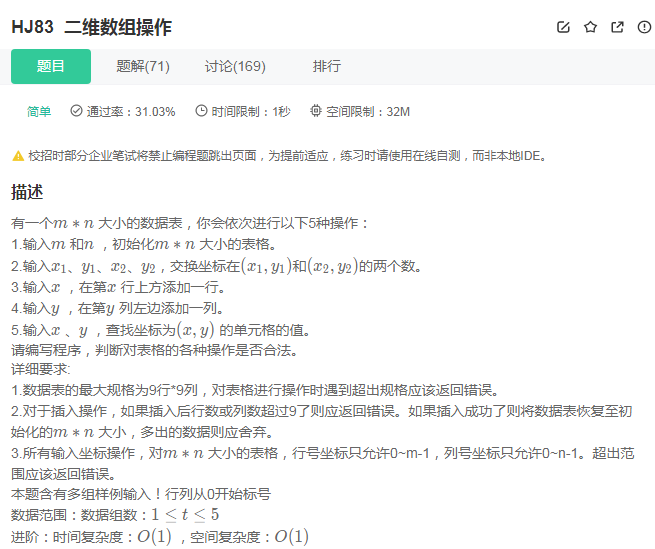
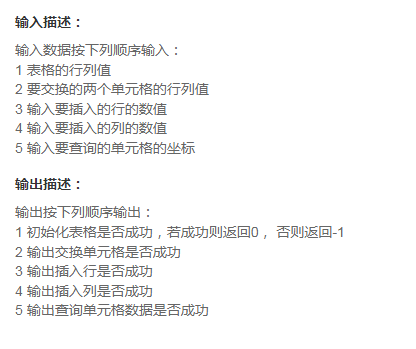
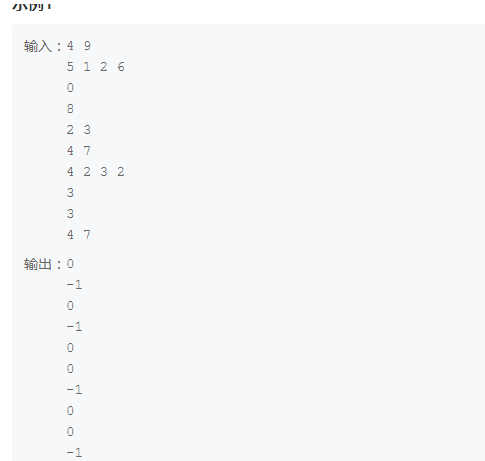
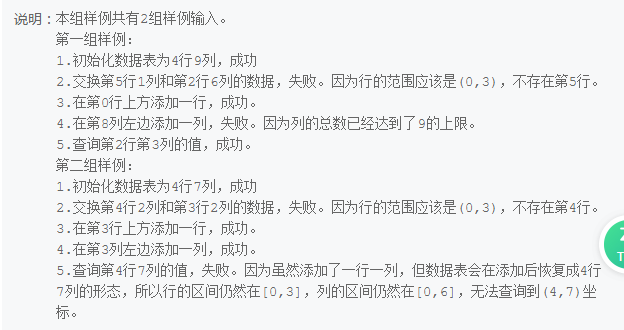
参考答案

1 while True: 2 try: 3 m, n = map(int, input().split()) 4 if 0 <= m <= 9 and 0 <= n <= 9: 5 print(0) 6 else: 7 print(-1) 8 9 x1, y1, x2, y2 = map(int, input().split()) 10 if 0 <= x1 <= m - 1 and 0 <= x2 <= m - 1 and 0 <= y1 <= n - 1 and 0 <= y2 <= n - 1: 11 print(0) 12 else: 13 print(-1) 14 15 x = int(input()) 16 if 0 <= x <= m - 1 and m + 1 <= 9: 17 print(0) 18 else: 19 print(-1) 20 y = int(input()) 21 if 0 <= y <= n - 1 and n + 1 <= 9: 22 print(0) 23 else: 24 print(-1) 25 x, y = map(int, input().split()) 26 if 0 <= x <= 9 and 0 <= y <= 9 and 0 <= x <= m - 1 and 0 <= y <= n - 1: 27 print(0) 28 else: 29 print(-1) 30 except: 31 break 32 33 ##################################################### 34 def create_table(x,y): 35 if 0 < x <= 9 and 0 < y <= 9: 36 global mytable 37 mytable = [[i + j for j in range(y)] for i in range(x)] 38 print('0') 39 else: 40 print('-1') 41 42 def func(x,a): 43 return True if x in range(a) else False 44 45 def exchange_value(x1,y1,x2,y2): 46 if all(map(func,[x1,x2],[a,a])) and all(map(func,[y1,y2],[b,b])): 47 mytable[x1][y1],mytable[x2][y2] = mytable[x2][y2],mytable[x1][y1] 48 print('0') 49 else: 50 print('-1') 51 52 def add_row(x): 53 if func(x,a) and a + 1 <= 9: 54 mytable.insert(x-1, [j for j in range(b)]) 55 mytable.pop() 56 print('0') 57 else: 58 print('-1') 59 60 def add_colomn(y): 61 if func(y,b) and b + 1 <= 9: 62 for i in range(a): 63 mytable[i].insert(y-1, i) 64 mytable[i].pop() 65 print('0') 66 else: 67 print('-1') 68 69 def check_cell(x,y): 70 if func(x,a) and func(y,b): 71 print('0') 72 else: 73 print('-1') 74 75 while True: 76 try: 77 a,b = map(int,input().split()) 78 create_table(a, b) 79 c,d,e,f = map(int,input().split()) 80 exchange_value(c,d,e,f) 81 g = int(input()) 82 add_row(g) 83 h = int(input()) 84 add_colomn(h) 85 k,l = map(int,input().split()) 86 check_cell(k,l) 87 except: 88 break 89 90 91 ###################################################### 92 93 m,n = list(map(int,input().split())) 94 95 x = int(input()) #3、输入要插入的行数 96 y = int(input()) # 4、输入要插入的行数 97 # print(m,n) 98 s =m*n 99 100 #1、初始化表格 101 if 1<=m and n<10: 102 print(0) 103 else: 104 print(-1) 105 106 # #2、交换数字 107 # x1, y1, x2, y2 =list(map(int,input().split())) 108 # 109 # if x1 >m or y1>n or x2 >m or y2>n : 110 # print(-1) 111 112 113 114 115 if 1<=x+m<10: 116 print(0) 117 s = m * n 118 else: 119 print(-1) 120 121 if 1 <= y + n < 10: 122 print(0) 123 s = m * n 124 else: 125 print(-1) 126 # print(s) 127 128 if (0<x<=m and 1<=x+m<10) and (0<y<=n and 1<=y+n<10): 129 print(0) 130 elif x>m or y>n: 131 print(-1)


参考答案

1 s = input() 2 print(s) 3 L1 = ['A', 'B', 'C', 'D', 'E', 'F', 'G',....] 4 L2 = [] 5 6 for a in range(len(s)): 7 if s[a] in L1: 8 L2.append(s[a]) 9 print(len(L2)) 10 11 ########################################### 12 ##法二 用字符串的比大小!>='A' <='Z' 13 while True: 14 try: 15 s = input() 16 L2 = [] 17 for a in range(len(s)): 18 if 'A' <= s[a] <= 'Z': 19 L2.append(s[a]) 20 print(len(L2)) 21 except: 22 break 23 ########################################### 24 25 while True: 26 27 try: 28 s=input() 29 res=0 30 for i in s: 31 if i.isupper(): 32 res+=1 33 print(res) 34 except: 35 break 36 37 ########################################### 38 #法三:用ord() ASCll表 <91 and ord(i)>64 39 while True: 40 try: 41 s = input() 42 n=0 43 for i in s: 44 if ord(i)<91 and ord(i)>64: 45 n=n+1 46 print(n) 47 except: 48 break
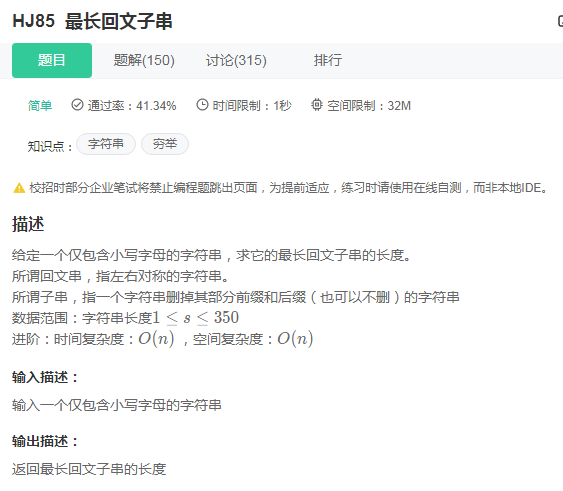
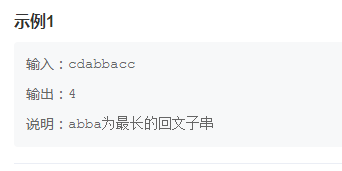
参考答案

1 while True: 2 try: 3 s = input() 4 res = [] 5 6 for i in range(len(s)): 7 for j in range(i + 1, len(s) + 1): 8 if s[i:j] == s[i:j][::-1]: 9 res.append(j - i) 10 if res != '': 11 print(max(res)) 12 except: 13 break 14 15 16 17 18 while True: 19 try: 20 s = input() # 输入 21 len_s = len(s) 22 result = 0 # result用于记录目前最长的子串长度,初始化为0 23 for n in range(len): # 从第一个字符的位置开始检查 24 max_len = result + 1 # max_len代表当前检查字符串的长度 25 while n + max_len <= len: # 代表搜索完以第n+1个字符串开头的所有字符串 26 if s[n:n + max_len] == s[n:n + max_len][::-1]: # 如果满足是回文字符串 27 result = max_len # 则此时最大的字符串长度变为max_len 28 max_len += 1 # 每次增加字符串的长度1 29 if result != 0: 30 print(result) 31 except: 32 break 33 34 35 36 37 38 39 40 l = input() 41 Max = 0 42 for i in range(len(l)): 43 for j in range(i,len(l)): 44 if l[i:j+1] == l[i:j+1][::-1] and j-i+1 > Max: 45 Max = j-i+1 46 else: 47 continue 48 print(Max) 49 50 51 while True: 52 try: 53 s = input() 54 n = len(s) 55 if n < 2: 56 print(n) 57 else: 58 dp = [[False] * n for _ in range(n)] 59 for i in range(n): 60 dp[i][i] = True 61 Max = 1 62 for l in range(2, n+1): 63 for i in range(n): 64 j = i + l - 1 65 if j >= n: 66 break 67 if s[i] != s[j]: 68 dp[i][j] = False 69 else: 70 if j - i < 3: 71 dp[i][j] = True 72 else: 73 dp[i][j] = dp[i+1][j-1] 74 if dp[i][j] and j + 1 - i > Max: 75 Max = j + 1 - i 76 print(Max) 77 except: 78 break 79 80 while True: 81 try: 82 s = input() 83 n = len(s) 84 if n < 2: 85 print(n) 86 87 max_len = 1 88 begin = 0 89 # dp[i][j] 表示 s[i..j] 是否是回文串 90 dp = [[False] * n for _ in range(n)] 91 for i in range(n): 92 dp[i][i] = True 93 94 # 递推开始 95 # 先枚举子串长度 96 for L in range(2, n + 1): 97 # 枚举左边界,左边界的上限设置可以宽松一些 98 for i in range(n): 99 # 由 L 和 i 可以确定右边界,即 j - i + 1 = L 得 100 j = L + i - 1 101 # 如果右边界越界,就可以退出当前循环 102 if j >= n: 103 break 104 105 if s[i] != s[j]: 106 dp[i][j] = False 107 else: 108 if j - i < 3: 109 dp[i][j] = True 110 else: 111 dp[i][j] = dp[i + 1][j - 1] 112 113 # 只要 dp[i][L] == true 成立,就表示子串 s[i..L] 是回文,此时记录回文长度和起始位置 114 if dp[i][j] and j - i + 1 > max_len: 115 max_len = j - i + 1 116 print(max_len) 117 except: 118 break
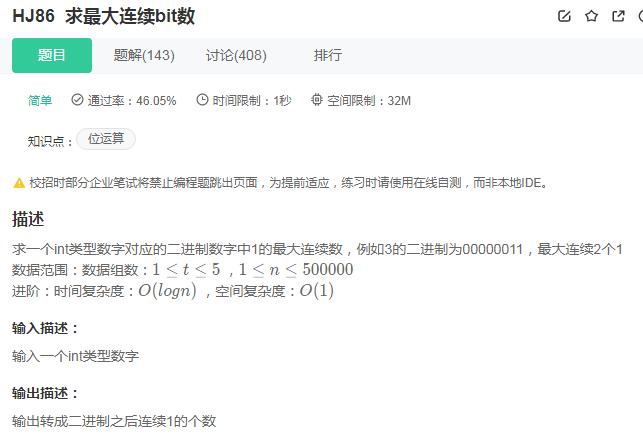
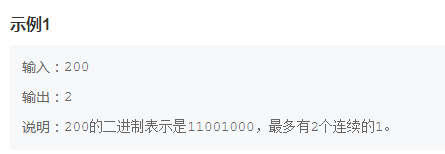
参考答案

1 while True: 2 try: 3 num = int(input()) 4 #print(bin(num)) 5 s = list(set(str(bin(num))[2:].split('0'))) 6 #print(s) 7 8 print(len(max(s))) 9 except: 10 break 11 12 13 while True: 14 try: 15 x = int(input()) 16 byte_x = bin(x)[2:] 17 list1 = sorted(list(set(byte_x.split('0'))), key = lambda x: len(x), reverse=True) 18 print(len(list1[0])) 19 except: 20 break 21 22 while True: 23 24 try: 25 s = input() 26 ## 数字格式-> 二元格式 -> 清除非数字 -> 零作为间隔符号 27 string = bin(int(s)).replace("0b", "").split("0") 28 longest = 0 29 for i in string: 30 count = i.count("1") 31 if count > longest: 32 longest = count 33 print(longest) 34 except: 35 break 36 37 38 while True: 39 try: 40 n = int(input()) 41 s = bin(n).replace('0b', '') 42 s = (8 - len(s)) * '0' + s 43 Max, count = 1, 1 44 i = s.index('1') 45 while i < len(s) - 1: 46 for j in range(i+1, len(s)): 47 if s[j] == '1': 48 count += 1 49 else: 50 break 51 Max = max(Max, count) 52 if '1' in s[j+1:]: 53 i = s.index('1', j+1) 54 count = 1 55 else: 56 break 57 print(Max) 58 except: 59 break 60 61 62 #################################################### 63 def get_ans(s): 64 ans=[] 65 res=0 66 mark=str(bin(int(s))) 67 for i in mark: 68 if i=='1': 69 res+=1 70 ans.append(res) 71 if i=='0': 72 ans.append(res) 73 res=0 74 return max(ans) 75 76 if __name__=='__main__': 77 import sys 78 lines = [] 79 while True: 80 line = sys.stdin.readline().strip() 81 if line == "": 82 break 83 lines.append(line) 84 for item in lines: 85 print(get_ans(item)) 86 #################################################### 87 88 while True: 89 try: 90 n=str(bin(int(input()))) 91 li=re.findall(r'1+', n) 92 q=max(map(len, li)) 93 print(q) 94 except: 95 break


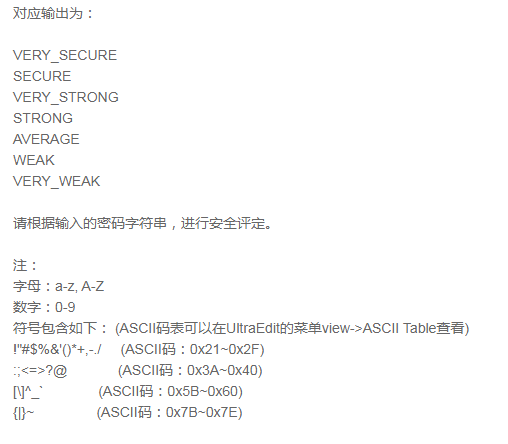
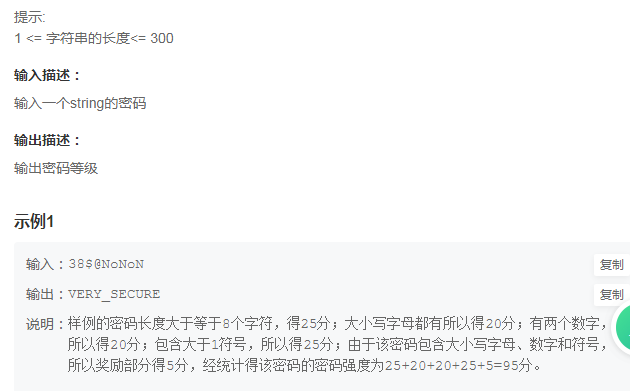
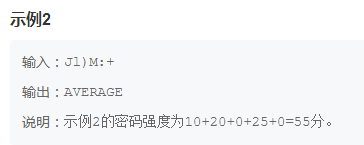
参考答案

1 # s = input() # 输入一个秘密 2 # 3 # print(s.isalpha()) 4 # 5 # print(s.isupper()) 6 # print(s.islower()) 7 8 while True: 9 try: 10 11 import re 12 13 14 def fun(pwd): 15 score = 0 16 # 规则一、密码长度: 17 if len(pwd) <= 4: 18 score += 5 19 elif 5<=len(pwd) <= 7: 20 score += 10 21 else: 22 score += 25 23 # 规则二、字母: 24 if re.findall('[a-z]', pwd) and re.findall('[A-Z]', pwd): 25 score += 20 26 elif re.findall('[a-z]', pwd) or re.findall('[A-Z]', pwd): 27 score += 10 28 else: 29 score += 0 30 # 规则三、数字: 31 #count = len(''.join(re.findall(r'\d+', pwd))) 32 count = len(re.findall(r'\d+', pwd)) 33 if count == 0: 34 score += 0 35 elif count == 1: 36 score += 10 37 else: 38 score += 20 39 # 规则四、符号: 40 count = len(''.join(re.findall('[^0-9a-zA-Z]', pwd))) 41 if count == 0: 42 score += 0 43 elif count == 1: 44 score += 10 45 else: 46 score += 25 47 # 规则五、奖励: 48 if re.findall('[a-z]', pwd) and re.findall('[A-Z]', pwd) and re.findall(r'\d+', pwd) and re.findall( 49 '[^0-9a-zA-Z]', pwd): 50 score += 5 51 elif re.findall('[a-zA-Z]', pwd) and re.findall(r'\d+', pwd) and re.findall('[^0-9a-zA-Z]', pwd): 52 score += 3 53 elif re.findall('[a-zA-Z]', pwd) and re.findall(r'\d+', pwd): 54 score += 2 55 # 判断等级 56 if score >= 90: 57 print('VERY_SECURE') 58 elif score >= 80: 59 print('SECURE') 60 elif score >= 70: 61 print('VERY_STRONG') 62 elif score >= 60: 63 print('STRONG') 64 elif score >= 50: 65 print('AVERAGE') 66 elif score >= 25: 67 print('WEAK') 68 elif score >= 0: 69 print('VERY_WEAK') 70 71 72 pwd = input() 73 fun(pwd) 74 except: 75 break
参考答案二,用字符串方式,很经典

1 def len_s(z): #密码长度得分 2 a = len(z) 3 if 0 < a <= 4: 4 return 5 5 elif 5 <= a <=7: 6 return 10 7 elif a >= 8: 8 return 25 9 else: 10 return 0 11 12 def low_s(z): #字母大小写得分 13 b = str(z) 14 sb = 0 #小写字母个数 15 bb = 0 #大写字母个数 16 for i in b: 17 if i.islower(): 18 sb += 1 19 if i.isupper(): 20 bb += 1 21 if (sb != 0 and bb == 0) or (sb == 0 and bb != 0): 22 return 10 23 if sb != 0 and bb != 0: 24 return 20 25 else: 26 return 0 27 28 def num_s(z): #数字个数得分 29 c = str(z) 30 nc = 0 31 for i in c: 32 if i.isdigit(): 33 nc += 1 34 if nc == 1: 35 return 10 36 if nc > 1: 37 return 20 38 else: 39 return 0 40 41 def symbol_s(z): #符号存在得分 42 d = str(z) 43 nd = 0 44 symbol = "!\"#$%&\'()*+,-./:;<=>?@[\\]^_`{|}~" 45 for i in d: 46 if i in symbol: 47 nd += 1 48 if nd == 1: 49 return 10 50 if nd > 1: 51 return 25 52 else: 53 return 0 54 55 def get_x(z): #奖励得分 56 e = str(z) 57 se = 0 58 le = 0 59 for i in e: 60 if i.islower(): 61 se += 1 62 if i.isupper(): 63 le += 1 64 if ((se != 0 and le == 0) or (le != 0 and se == 0)) and num_s(e) != 0: 65 return 2 66 if ((se != 0 and le == 0) or (le != 0 and se == 0)) and num_s(e) != 0 and symbol_s(e)!= 0: 67 return 3 68 if (se != 0 and le != 0) and num_s(e) != 0 and symbol_s(e)!= 0: 69 return 5 70 else: 71 return 0 72 73 while True: 74 try: 75 f = str(input()) 76 score = len_s(f) + low_s(f) + num_s(f) + symbol_s(f) + get_x(f) 77 if score >= 90: 78 print("VERY_SECURE") 79 if 80 <= score < 90: 80 print("SECURE") 81 if 70 <= score < 80: 82 print("VERY_STRONG") 83 if 60 <= score < 70: 84 print("STRONG") 85 if 50 <= score < 60: 86 print("AVERAGE") 87 if 25 <= score < 50: 88 print("WEAK") 89 if 0 <= score < 25: 90 print("VERY_WEAK") 91 except: 92 break 93 94 95 96 ########################################## 97 98 while True: 99 try: 100 pwd_str = input() 101 output_num = 0 102 # 一、密码长度: 103 if len(pwd_str) <= 4: 104 output_num += 5 105 elif 5 <= len(pwd_str) <= 7: 106 output_num += 10 107 elif len(pwd_str) >= 8: 108 output_num += 25 109 islower_num = 0 110 isupper_num = 0 111 isdigit_num = 0 112 isother_num = 0 113 for word in pwd_str: 114 if word.islower(): 115 islower_num += 1 116 elif word.isupper(): 117 isupper_num += 1 118 elif word.isdigit(): 119 isdigit_num += 1 120 else: 121 isother_num += 1 122 # 二、字母: 123 if islower_num == 0 and isupper_num == 0: 124 output_num += 0 125 elif (islower_num != 0 and isupper_num == 0) or (islower_num == 0 and isupper_num != 0): 126 output_num += 10 127 elif islower_num != 0 and isupper_num != 0: 128 output_num += 20 129 # 三、数字: 130 if isdigit_num == 0: 131 output_num += 0 132 elif isdigit_num == 1: 133 output_num += 10 134 elif isdigit_num > 1: 135 output_num += 20 136 # 四、符号: 137 if isother_num == 0: 138 output_num += 0 139 elif isother_num == 1: 140 output_num += 10 141 elif isother_num > 1: 142 output_num += 25 143 # 五、奖励: 144 if islower_num != 0 and isupper_num != 0 and isdigit_num != 0 and isother_num != 0: 145 output_num += 5 146 elif (islower_num != 0 or isupper_num != 0) and isdigit_num != 0 and isother_num != 0: 147 output_num += 3 148 elif (islower_num != 0 or isupper_num != 0) and isdigit_num != 0: 149 output_num += 2 150 151 if output_num >= 90: 152 print("VERY_SECURE") 153 elif output_num >= 80: 154 print("SECURE") 155 elif output_num >= 70: 156 print("VERY_STRONG") 157 elif output_num >= 60: 158 print("STRONG") 159 elif output_num >= 50: 160 print("AVERAGE") 161 elif output_num >= 25: 162 print("WEAK") 163 elif output_num >= 0: 164 print("VERY_WEAK") 165 except: 166 break
正则表达式,参考
Python之re模块





